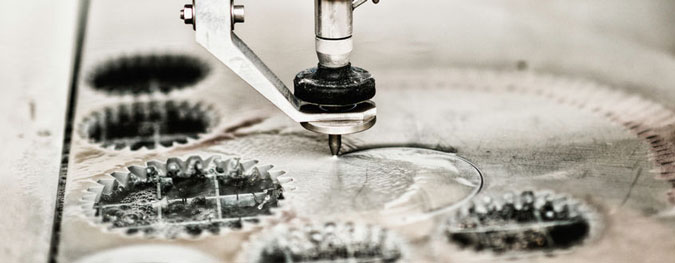
Waterjet cutting has really come to the forefront of manufacturing in recent years because of its versatility. There are an array of reasons to choose waterjet cutting over other methods, and they aren’t all about the actual cutting control. Improved efficiency in processes and reduced wastage and costs also factor highly, which by default leads to improved customer service.
Omni directional cutting, cutting widths, stress free cutting and improved finishing are all advantages of using water instead of more traditional cutting methods. However, one of the most fundamental things with waterjet cutting is that when you use water, there is no Heat Affected Zone (HAZ). This is the area around where you’re machining that gets hot because of the machining process. The heat generated in this area means the structure of the material gets altered and can be liable to fracture. If machining composite materials using traditional methods, the HAZ can cause all sorts of distortions and reactions, resulting in breakage and wastage. The ability to cut cold removes all these barriers and means that almost any material can now be cut with no alteration to its base structure.
As technology gets more innovative and cutting edge, so do customers machining requirements. Extremely complex designs, shapes and patterns can now be manufactured using waterjet cutting. There are no drill holes required at starting points meaning much sharper corners can be cut as well more curves. Traditional cutting and milling machines manufacture square shapes by profiling with a cutter, leaving a radius in the corner and then remachining multiple times until that radius becomes square. Waterjet cutting removes that need for multiple rounds of machining – it just cuts square! The time spent machining is reduced with no need for further finishing actions once the cutting is complete.
Of course there are other cutting options out there like laser or plasma, but in our opinion waterjet cutting is the most versatile and accurate. Laser cutters don’t cut thick materials as well as water does, with 25mm being about the maximum thickness whereas water can cut up to 100mm accurately. Plasma cutters can cut thicker materials, however at thicker levels of material, plasma cutters tend to lose their accuracy. For us at PRV Engineering, accuracy is essential for our projects and for providing great customer service.
Obviously, great accuracy has to be achieved in any project but a typical example of when the accuracy of waterjet cutting helps both the manufacturer and end client is the prototyping of sheet metal parts. Prototype products often require complex bends and stresses which can need recalculating if it’s discovered that there’s been a miscalculation of the bend structure or stress. For companies without water or laser cutting capabilities this involves sending a profile to someone else who will cut the item, put the bends put in after the cut and return it to you. Sometimes it just doesn’t work out the way you thought it would and when you get it back, you have to tweak your calculations and start the process all over again. By having our own waterjet cutting machinery, we can not only cut and bend prototype products, but if necessary, recalculate and reproduce in a matter of minutes.
Waterjet cutting allows us at PRV Engineering to manufacture parts in any type of material in a way that can’t be done using conventional milling machines or drills. It gives us total control over projects from concept and design through prototyping and on to the manufacture of the end product.
Our wide range of products and services across multiple industries combined with our expertise means that clients have just one point of contact for their whole project, from start to finish.
Get in touch to find out if waterjet cutting would be beneficial in your next project.
Image Copyright: microgen / 123RF Stock Photo
This site uses Akismet to reduce spam. Learn how your comment data is processed.


 Mail:
Mail: 





Leave a Comments